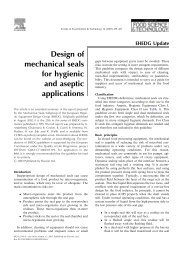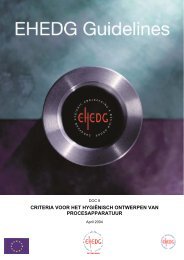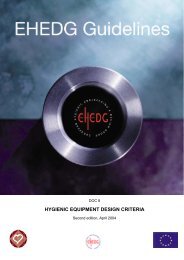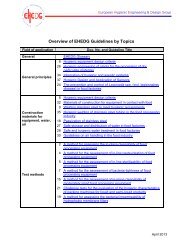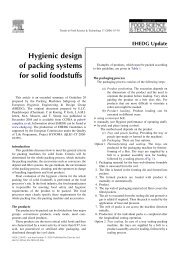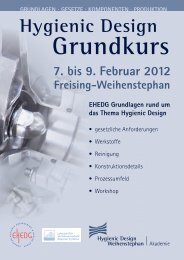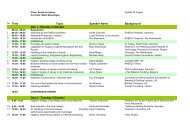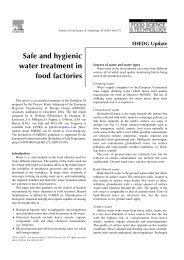Yearbook 2013/2014 - ehedg
Yearbook 2013/2014 - ehedg
Yearbook 2013/2014 - ehedg
You also want an ePaper? Increase the reach of your titles
YUMPU automatically turns print PDFs into web optimized ePapers that Google loves.
European Hygienic Engineering & Design Group<br />
Spray cleaning systems in food processing machines and<br />
the simulation of CIP-coverage tests<br />
The intelligent usage of experimental and simulated cleanability tests is a further step toward<br />
the reduction of machinery development time and costs and time of machinery for the food and<br />
pharmaceutical industry.<br />
André Boye 1 , Marc Mauermann 1 , Daniel Höhne 2 , Jens-Peter Majschak 1<br />
1<br />
Fraunhofer IVV, Branch Lab for Processing Machinery and Packaging Technology AVV Dresden, Germany<br />
2<br />
Technische Universität Dresden, Faculty of Computer Science, Institute of Software- and Multimedia-Technology,<br />
Dresden, Germany<br />
e-mail: andre.boye@avv.fraunhofer.de<br />
Due to increasing hygienic requirements, more and more<br />
machinery for the food industry is delivered with automated<br />
clean-in-place (CIP) systems. By using such systems,<br />
hygienic risks may decrease and cleaning efficiencies may<br />
rise.<br />
The validation of the hygienic design of such systems, and<br />
thus the selection of specific nozzles for cleaning, their<br />
alignment and built-in position has so far been done so far<br />
only on a real prototype by means of CIP-coverage tests.<br />
The objective of this test is to verify that the cleaning systems<br />
associated with the machinery are capable of delivering<br />
cleaning solutions to all exposed product contact surfaces. If<br />
that is not the case, the cleaning system has to be adjusted<br />
and tested further until all surfaces are wetted with cleaning<br />
agent in the coverage test. This iterative optimisation is<br />
extremely time-consuming and has very high resource<br />
requirements (e.g., staff, material, etc.). Hence, many costs<br />
arise that are also hardly calculable when submitting a<br />
tender offer.<br />
An approach to improving the hygienic design of food<br />
processing machinery is to simulate the coverage test<br />
using the computer-aided design (CAD) data of the<br />
machinery and the cleaning system. This paper presents a<br />
software solution that is capable of simulating the coverage<br />
of relevant equipment surfaces with cleaning fluids from<br />
nozzles by means of ray tracing. The main differences<br />
between CAD and computational fluid dynamics (CFD)<br />
methods are that the simulation is much easier to handle,<br />
simpler in degree of detail of the results, works in real-time<br />
and can be used for optimising cleaning systems with a<br />
huge number of nozzles. The main requirements for the<br />
software design were that the software should not have high<br />
demands on construction engineers with regard to the level<br />
of simulating knowledge and should be very practicable for<br />
complex systems.<br />
For characterising the spray pattern as a precondition for<br />
integrating different nozzles in this software, an adequate<br />
cleanability test was found. By means of the test rig,<br />
characteristics of different cleaning nozzles can be<br />
analysed, classified and provided in an electronic format.<br />
In summary, the complete package consists of the software<br />
and new test method for spray pattern characterisation.<br />
Software for the simulation of spray shadows<br />
(a)<br />
(b)<br />
Figure 1. Screenshots of the developed (a) simulation software and<br />
(b) nozzle explorer for selecting a nozzle from the database.<br />
With the simulation software developed, engineers are<br />
given the opportunity to optimise their cleaning systems at<br />
computers before any components of a new machine have<br />
to be manufactured (Figure 1). Thereby, the presented tool<br />
gives an estimation for the spray pattern on complex parts in<br />
relation to the specific cleaning systems.<br />
Software usage and features<br />
Import CAD assembly<br />
Choose view<br />
Insert nozzles<br />
Figure 2. Flow chart for software usage.<br />
Export position of nozzles<br />
Inspection of cleaning<br />
results/ optimisation<br />
Positioning/ alignment<br />
As shown in Figure 2, there are a number of software usage<br />
functions and features. At first, the user opens a new project<br />
and loads the CAD assembly of the object to be cleaned<br />
by using standardised exchange formats. In the next step,<br />
the view can be chosen like in standard CAD software and<br />
the nozzles are inserted via drag-and-drop, with quantity and



